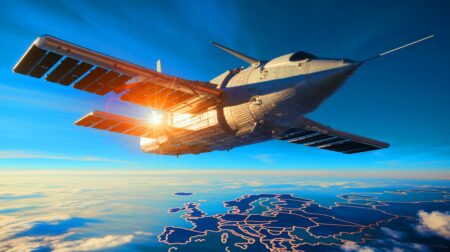| IN A NUTSHELL |
|
China is making significant strides in its naval capabilities with the construction of a nuclear-powered warship. This development marks a crucial advancement for the nation, potentially elevating its maritime influence on a global scale. Currently, China boasts the largest number of naval vessels worldwide, yet the fleet is often criticized for lacking modern capabilities. The new nuclear-powered aircraft carrier could address these concerns, offering enhanced endurance and operational range. Such advancements could place China alongside the United States and France as nations possessing nuclear-powered carriers, thereby reshaping the balance of naval power.
China’s Ambitious Nuclear-Powered Warship Project
In 2024, the Middlebury Institute of International Studies in California confirmed through research that China was actively developing a nuclear-powered propulsion system for a new warship. This initiative was further substantiated by satellite imagery and documents analyzed by the Associated Press (AP), which revealed Beijing’s progress in constructing a land-based prototype nuclear reactor. This reactor is designed to power a large surface warship, indicating China’s serious commitment to advancing its naval technology.
Images from the Dalian shipbuilding facility in China, studied by experts in the US, show significant advancements in the construction of this nuclear-powered vessel. Notably, the warship’s design allows for fighter jets to be launched from four parts of the flight deck, a novel feature absent from China’s existing fleet. This innovative design suggests a strategic shift in Beijing’s naval warfare capabilities, aiming to enhance tactical flexibility and operational effectiveness. Despite the compelling evidence, Chinese officials have remained silent on these developments, refraining from making public claims about this potentially game-changing warship.
PLA Navy’s Current Fleet and Future Aspirations
The People’s Liberation Army (PLA) Navy currently operates three aircraft carriers: Liaoning, Shandong, and Fujian. While these carriers were built in recent years, they are conventionally powered, limiting their operational range compared to nuclear-powered counterparts. Nuclear-powered warships offer the advantage of extended deployment periods without requiring refueling, a critical factor for sustained maritime operations. Consequently, acquiring such a vessel is a logical progression for China’s naval ambitions.
The Fujian, launched three years ago, was China’s first domestically built aircraft carrier to incorporate electromagnetic technology for launching fighter jets. Despite being the “world’s largest conventionally powered warship” with a displacement of 80,000 tonnes, according to CCTV, it still falls short of the capabilities offered by nuclear propulsion. Last year, China revealed an amphibious assault ship with jet-launching capabilities, showcasing an electromagnetic catapult system similar to the one proposed for the new nuclear-powered carrier. These developments indicate a clear trajectory towards modernizing China’s naval fleet, aligning it more closely with leading military powers.
US Wholesale Prices Stay High, Indicating Inflation May Linger
Technological Innovations and Strategic Implications
The integration of electromagnetic catapults in China’s new warship underscores a significant technological leap. These catapults enable rapid deployment of fighter jets, potentially transforming the operational dynamics of China’s navy. Such advancements are pivotal in matching the capabilities of the USS Gerald R. Ford, the US Navy’s leading nuclear-powered aircraft carrier. By achieving parity with such formidable vessels, China could redefine its maritime strategy, enhancing its ability to project power and influence across the globe.
This technological progress not only bolsters China’s defensive and offensive capabilities but also signals its intent to assert greater influence in international waters. The introduction of a nuclear-powered aircraft carrier could shift the balance of power in strategic maritime regions, necessitating adjustments in global naval strategies. As China continues to enhance its naval technology, the geopolitical implications of these advancements are profound, potentially altering the dynamics of global maritime security.
Challenges and Opportunities Ahead
Despite the promising advancements in China’s naval technology, the journey to operationalizing a nuclear-powered warship is fraught with challenges. Developing a reliable and efficient nuclear propulsion system requires overcoming significant technical hurdles, including reactor design, safety protocols, and integration with existing naval systems. Furthermore, the construction of such a sophisticated vessel demands considerable resources and expertise, necessitating collaboration across various sectors of China’s defense industry.
However, the successful realization of this project presents substantial opportunities for China. It would not only enhance its military capabilities but also serve as a testament to its technological prowess and strategic foresight. As China continues to invest in its naval modernization efforts, the international community will closely monitor these developments, assessing their potential impact on global security dynamics. The question remains: How will China’s burgeoning naval capabilities shape the future of international maritime relations?
Did you like it? 4.3/5 (21)









Wow, a 1,100-foot warship? That’s massive. How does it compare to US carriers in terms of size?
All of our aircraft carriers are approximately 1100′, and we have more carriers than the rest of the world, combined. Like everything China makes, this will likely be a cheap copy of superior US technology.
China’s really stepping up their game. Do you think this will lead to an arms race at sea? 🌊
Interesting article! But I’m curious, how long will it take for China to fully operationalize this warship?
Is it just me or does this sound like something out of a sci-fi movie? 🚀
Will this new ship have any environmental impacts compared to traditional carriers? 🤔
With all these advancements, what does the international community think about China’s naval expansion?
I wonder how the crew will be trained to handle such advanced technology. Any thoughts?
So, is this warship a direct response to the US Navy’s capabilities?
Lol, I hope they have enough parking space for those fighter jets. 😂
How does the integration of electromagnetic catapults work? Sounds futuristic! ⚡
This article raises more questions than answers. What about the implications for Taiwan?
Great read! Thanks for keeping us updated on global naval developments. 👍
Can someone explain why nuclear propulsion is such a big deal for ships?
Nuclear propulsion allows ship to be at sea for years without needing fuel. It’s also much more efficient than diesel powered vessels. A reactor is costly to build and fuel at start, but once in operation will need little to no maintenance and will continually operate for years nonstop.
Hope this doesn’t escalate into more tensions on the high seas. 😬
Why are they keeping everything so hush-hush? 🤐
This is cool and all, but how will it affect China’s economy? Spending must be huge!
Just curious, what are the potential security risks of having nuclear-powered ships? ☢️
If we’re talking about US nuclear powered ships, the risk of a meltdown or radiation leak is incredibly small. The amount of nuclear fuel is far less than a nuclear power plant (which are also incredibly safe) and there are safety protocols in place that makes a nuclear incident almost impossible.
As far as the Chinese propulsion system, that’s a big question mark, but even in the event of a full-blown meltdown, the fact that it’s out at sea makes any fallout unlikely to affect civilians and provides the ship with an endless supply of water to cool down a runaway core.
Is the US worried about this? I’d imagine they’re keeping a close eye on these developments.
So, when can we expect to see this titan in action? Any timelines mentioned?
China’s definitely making waves with this one. Pun intended! 😉
Does this mean the US and China will need to negotiate new maritime treaties?
What happens if there’s a reactor issue on board? Safety first, right?
How advanced is China’s current shipbuilding technology compared to other nations?
Thank you for the detailed coverage. It’s fascinating to see how global dynamics are shifting.
Can this warship really challenge US naval dominance? Seems ambitious! 🌍
Not unless they build another two dozen of these, and they actually function as well as US carriers. China always builds planes, ships, and other military equipment that looks similar to US equipment, but that never functions as well. The concept of cheap Chinese knockoffs isn’t limited to consumer goods.
Why aren’t Chinese officials talking about this more openly? 🤨
How many more ships like this does China plan to build? Are they going all in?
Is there any talk about collaborations or partnerships with other countries for this project?